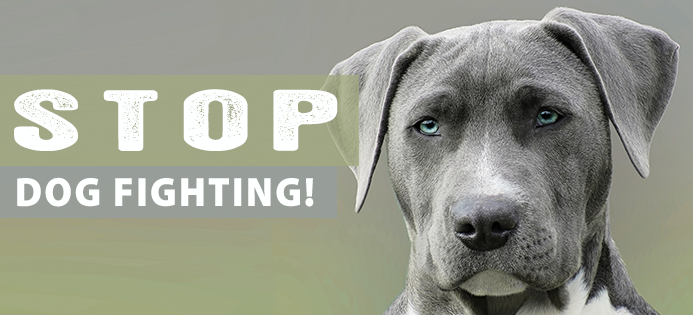Dog Fighting
Dog fighting occurs when two dogs (that are trained to fight) are placed in a pit and forced to attack each other until only one is left standing. This is typically done for either entertainment or for profit.
Click here to read LCA's alerts about dogfighter Michael Vick.
Levels of Dog Fighting
- Professional dogfighters generally travel the country and around the world breeding and fighting dogs for profit.
- Hobbyists may have a handful of dogs that they breed and follow the ruled of a refereed dogfight, but they usually stay at the local level.
- Street fighters fight all breeds of dogs and normally do not keep track of a dog's record or bloodlines.
Criminal Activity and the Treat to Public Safety
- Dog fight spectators are typically involved in illegal gambling and bet money on which dog they believe will prevail.
- Weapons are common at dogfights because of the large amount of cash that is typically present.
- Major drug networks have been tied to animal fighting in several states, and raids on animal fighting operations have resulted in the seizure of large-scale drug operations and reveal underground drug manufacturing labs.
- Dog fighters and spectators generally have a history of violent and criminal behavior towards people.
- Dog fighting is sometimes used as entertainment for gangs.
- Dogs used in dog fighting are trained to be aggressive. Their presence in the community places others at risk of attack.
The Training
- Starvation to encourage malice.
- Beatings to build “endurance.”
- Forced exhausting exercise. For example, to strengthen the jaw of a fighting dog, the dog will be hung from a tree for hours by biting on to a rope.
- Small animals, such as cats, kittens, puppies, and rabbits, are often stolen to be used as training bait. These animals are hung from trees or tall buildings and then mauled to death.
The Fighting
- Spectators often prod dogs with sharp objects and hit them to force continued fighting. They are frequently made to fight until one of them dies.
- Undercover investigators who have infiltrated dog fighting rings found blood-soaked dogs with life-threatening injuries left to die when no longer "game.” The injuries include: ripped ears, torn lips, genitals ripped and dangling, eyes swollen shut, and faces so riddled with puncture wounds that the dogs were barely able to breathe.
After the Fight
- Dogs who survive a fight often die from blood loss, shock, dehydration, exhaustion or infection.
- Once a dog is too injured to fight, the street fighters either dump it or kill it. Shelters are often full of fighting dogs that have been discarded, adding to the millions of abandoned companion animals who are euthanized each year. Pit bulls have trouble getting adopted because of bad press, but these dogs can be wonderful companions. Pit bulls that have been trained to fight and are abandoned at shelters usually end up being euthanized.
Children
Dog fighters or spectators often involve their children in dog fighting. Research shows young children who view this type of violence have a greater acceptance of aggressive attitudes and behaviors. They are taught to believe that violence is entertaining, that it is okay to inflict the cruelties they observe, and that dog fighting is an acceptable form of recreation.
Dogfighting locations
• Abandoned houses
• Vacant garages
• Isolated warehouses
• Commercial or residential basements
• Secluded parks
• Farmhouses or barns
Breeds of Dogs Commonly Involved in Dog Fighting
Dogs which have the appearance and characteristics of a:
• Staffordshire Bull Terrier
• American Pit Bull Terrier or
• Any other breed commonly known as “pit bull”
• Other large breeds of dogs
Characteristics of Dogs Used in Dog Fighting
• Short ear crops
• Wounds and abscesses
• Scars on the head, throat, legs, and ears
• Wide leather or web collars with heavy rings
• Puncture wounds and lacerations
• Bleeding dogs and/or blood stains in a confined area
• Severe injuries that can result in death from loss of blood and internal trauma
The Law
• Dog fighting is a felony offense in all 50 states.
• Being a spectator at a dogfighting event is illegal in 48 states.
• The possession of dogs for fighting purposes is prohibited in all 50 states.
Contact Your Elected Officials
Your elected officials’ contact information can be found at www.votesmart.org — they need to hear from you!
• If your state has not made it a felony to be a spectator at a dogfight (e.g., AK, AR, CA, GA, HI, ID, IN, IA, KS, KY, ME, MD, MN, MO, MT, NV, NY, ND, OK, SC, SD, TN, TX, UT, WV, WI,WY), write to your elected officials and ask them to do so.
• If your state has not made the possession of dogs for fighting a felony (e.g., NV, NY, TX, WV), write to your elected officials and ask them to do so.
How Can You Help?
• If you suspect dog fighting is occurring in your neighborhood, contact the police immediately.
• Volunteer with a dog rescue group.
• Educate your community about the horrors of dog fighting; contact LCA for more information.
• Teach respect for all life.
• Sign up for LCA Action Alerts and keep informed on our dog fighting campaign and other ways you can help animals
• Volunteer with LCA, contact This email address is being protected from spambots. You need JavaScript enabled to view it. or call 310-271-6096 x27.












